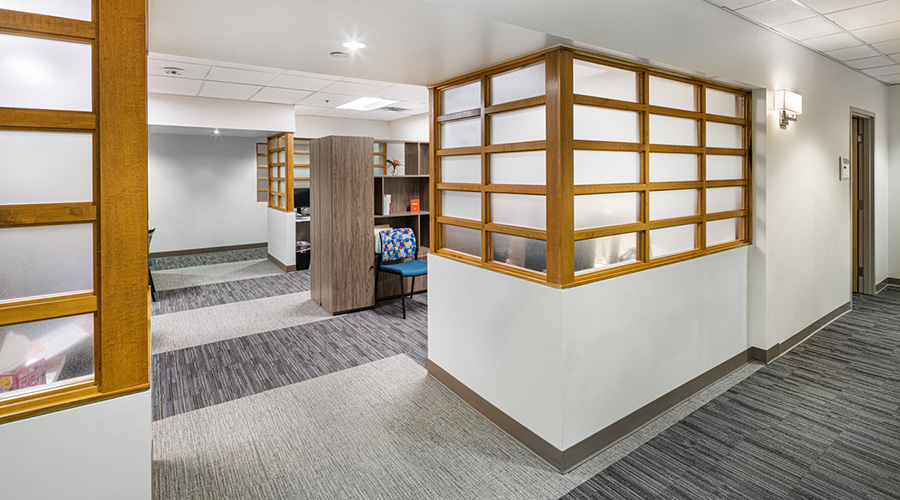While hospitals and other healthcare facilities are meant as a safe place for people to go and heal, oftentimes they bring on a new set of stressors for both the patient and their loved ones. To better combat this, healthcare facilities have started working to improve the overall patient experience by managing the four areas of comfort: thermal controls, lighting, noise management and mobility. Managing at least two of these four areas allows the facilities team the capability to monitor and track reliability in support of the patient-centered environment.
Healthcare Facilities Today recently spoke with Brad Shokes, managing director, healthcare division, JLL, about how facilities teams can best address the physical environment to better improve the patient experience.
HFT: How does the physical environment of healthcare facilities contribute to the overall patient experience?
Brad Shokes: Usually, no one walks into a hospital, either as a patient or visitor, and wants to be there. The stress and anxiety associated with illness or trauma is difficult. An experience that mitigates the stress of being there helps patients concentrate on their wellbeing. Whether its cleanliness of the space, wayfinding for loved ones to visit, or ensuring the facility is comfortable and welcoming, the physical environment is an often-overlooked critical variable to ensuring a patient has a positive experience.
HFT: What specific aspects of facility design or layout are important for enhancing patient comfort and well-being?
Shokes: Aesthetics continue to play an important role in ensuring patients are comfortable and relaxed while in hospital. Design of rooms continues to evolve and drive toward a single patient environment. Although slow to evolve, we continue to see new designs focusing on a singular experience. Rooms today need to accommodate family members as well. Ask yourself: Is there seating for their partner or loved ones? Is there a place for one to sleep if they are staying overnight with their loved one?
A good example is windows. Historically, windows in facilities may not have been designed to support the view for the patient. If a patient has a window, they don’t want it behind their bed, so we must find a way to support the ability for a patient to see outside and provide that much needed view of nature to help soothe the stresses they have.
Many designs now incorporate refrigerators to store personal snacks and items, and this amenity allows the patient to personalize their experience. Additionally, color is very important in the design of space to create calmness. Blues and greens now often adorn the space rather than a drab old gold wall. We also see gaming systems incorporated into space now, which accommodates a growing demographic of the market. Other comforts patients appreciate is a space where things like scales aren’t out in plain sight of others – or vitals posted where others can see.
HFT: How can facilities managers best address noise control and create a quiet and peaceful environment for patients?
Shokes: Often a bit more expensive, building out space with noise reducing products such as rubber flooring helps to absorb sound. Also, in spaces where it is conducive, hospitals should include baffling in the walls and above ceilings to reduce noise. Simple activities like maintaining the carts that nurses and/or maintenance technicians utilize can make a bid difference, in addition to implementing processes that prevent conversations in patient focused areas help to address noise issues.
HFT: What measures should facilities managers take to maintain a clean and hygienic environment within healthcare facilities, and how does this impact the patient experience?
Shokes: A best practice that we utilize is completing an Infection Control Risk Assessment anytime maintenance work is completed in a patient environment to ensure that we take all needed precautions to ensure a clean environment. Process controls that help to ensure a low risk of a hospital acquired infection also include covering carts that may have or could accumulate debris; wiping down wheels on service carts before entering patient care areas; ensuring high-touch surfaces are cleaned consistently; establishing a regular routine to empty trash; and wash your hands and wash your hands and wash your hands!
HFT: How does effective maintenance and attention to details, such as waiting rooms, cleanliness, and safety, contribute to overcoming the limitations of an older facility?
Shokes: Painting programs in common areas offer a common and simple solution to making any space feel updated and comfortable. This includes regular inspection and consistent routines to paint and patch damaged areas. Also, small upgrades like LED lighting can create a brighter and more vibrant space, as lighting and color create aesthetics that make people comfortable.
Not unlike a world-class safety culture, we want to empower technicians to look for and address any cleaning issues immediately, which can be as simple as picking up trash when they see it. Proper maintenance is critical to ensure that older and aging equipment continues to run well and support the infrastructure of the buildings. All teams must adhere and follow the manufacturer recommendations or use and OEM partner to service all critical infrastructure. This preventive maintenance prevents emergencies and disruptions in patient care.
The appropriate process for declaring the need for capital replacements is necessary. We can’t maintain old equipment forever, so a capital renewal program will keep hospitals ahead of the curve in planning for major projects to support the facilities.
HFT: How can facilities managers measure and evaluate the impact of facility improvements on patient satisfaction and outcomes?
Shokes: The facilities team should partner with their clinical colleagues to understand patient surveys and address how the physical environment impacts their experience. Any hospital-based facility team should be focused on reducing the amount of hospital acquired infections that are related to the physical environment, which can be directionally measured based on their performance on their regulatory surveys. Keeping people from getting sicker at the hospital greatly impacts patient satisfaction.
Mackenna Moralez is the associate editor of the facilities market.

 Ribbon Cutting Marks First Phase Completion for New Montefiore Einstein Facility
Ribbon Cutting Marks First Phase Completion for New Montefiore Einstein Facility Brooks Rehabilitation Launches 3 New Major Construction Projects
Brooks Rehabilitation Launches 3 New Major Construction Projects Joint Commission Standards: What Updates Matter Most?
Joint Commission Standards: What Updates Matter Most? Swinerton Completes Construction at Atlanta's Grady Hospital
Swinerton Completes Construction at Atlanta's Grady Hospital NY Governor Hochul Announces $300M in Funds for IT and Cybersecurity
NY Governor Hochul Announces $300M in Funds for IT and Cybersecurity